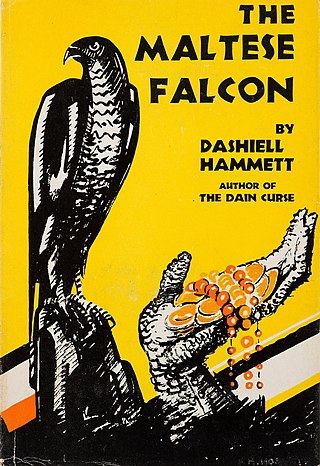
The Maltese Falcon is a 1930 detective novel by American writer Dashiell Hammett, originally serialized in the magazine Black Mask beginning with the September 1929 issue. The story is told entirely in external third-person narrative; there is no description whatsoever of any character's thoughts or feelings, only what they say and do, and how they look. The novel has been adapted several times for the cinema.

Samuel Dashiell Hammett was an American writer of hard-boiled detective novels and short stories. He was also a screenwriter and political activist. Among the characters he created are Sam Spade, Nick and Nora Charles, The Continental Op and the comic strip character Secret Agent X-9.
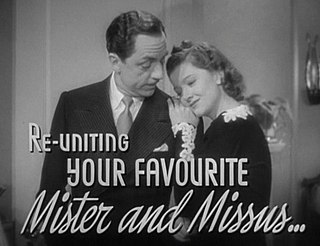
Nick and Nora Charles are fictional characters created by Dashiell Hammett in his novel The Thin Man. The characters were later adapted for film in a series of films between 1934 and 1947; for radio from 1941 to 1950; for television from 1957 through 1959; as a Broadway musical in 1991; and as a stage play in 2009.

Mystery is a fiction genre where the nature of an event, usually a murder or other crime, remains mysterious until the end of the story. Often within a closed circle of suspects, each suspect is usually provided with a credible motive and a reasonable opportunity for committing the crime. The central character is often a detective, who eventually solves the mystery by logical deduction from facts presented to the reader. Some mystery books are non-fiction. Mystery fiction can be detective stories in which the emphasis is on the puzzle or suspense element and its logical solution such as a whodunit. Mystery fiction can be contrasted with hardboiled detective stories, which focus on action and gritty realism.

Black Mask was a pulp magazine first published in April 1920 by the journalist H. L. Mencken and the drama critic George Jean Nathan. It is most well-known today for launching the hardboiled crime subgenre of mystery fiction, publishing now-classic works by Dashiell Hammett, Raymond Chandler, Erle Stanley Gardner, Cornell Woolrich, Paul Cain, Carroll John Daly, and others.
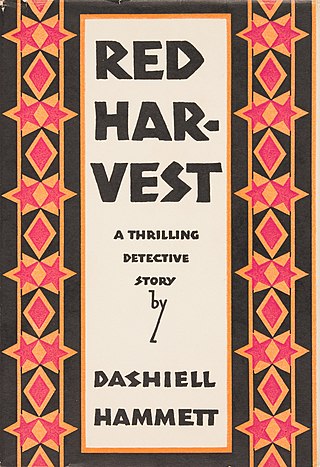
Red Harvest (1929) is a novel by American writer Dashiell Hammett. The story is narrated by the Continental Op, a frequent character in Hammett's fiction, much of which is drawn from his own experiences as an operative of the Pinkerton Detective Agency. The plot follows the Op's investigation of several murders amid a labor dispute in a corrupt Montana mining town. Some of the novel was inspired by the Anaconda Road massacre, a 1920 labor dispute in the mining town of Butte, Montana.
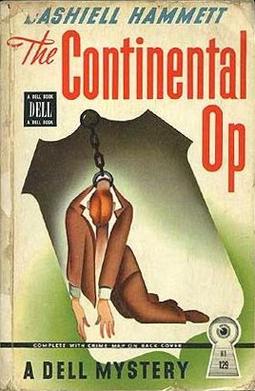
The Continental Op is a fictional character created by Dashiell Hammett. He is a private investigator employed as an operative of the Continental Detective Agency's San Francisco office. The stories are all told in the first person and his name is never given.

Hardboiled fiction is a literary genre that shares some of its characters and settings with crime fiction. The genre's typical protagonist is a detective who battles the violence of organized crime that flourished during Prohibition (1920–1933) and its aftermath, while dealing with a legal system that has become as corrupt as the organized crime itself. Rendered cynical by this cycle of violence, the detectives of hardboiled fiction are often antiheroes. Notable hardboiled detectives include Dick Tracy, Philip Marlowe, Nick Charles, Mike Hammer, Sam Spade, Lew Archer, Slam Bradley, and The Continental Op.

Chester Bomar Himes was an American writer. His works, some of which have been filmed, include If He Hollers Let Him Go, published in 1945, and the Harlem Detective series of novels for which he is best known, set in the 1950s and early 1960s and featuring two black policemen called Grave Digger Jones and Coffin Ed Johnson. In 1958 Himes won France's Grand Prix de Littérature Policière.

The Glass Key is a novel by American writer Dashiell Hammett. First published as a serial in Black Mask magazine in 1930, it then was collected in 1931. It tells the story of a gambler and racketeer, Ned Beaumont, whose devotion to Paul Madvig, a crooked political boss, leads him to investigate the murder of a local senator's son as a potential gang war brews. Hammett dedicated the novel to his onetime lover Nell Martin.

The Dain Curse is a novel by American writer Dashiell Hammett, published in 1929. Before its publication in book form, it was serialized in Black Mask magazine in 1928 and 1929.
Satan Met a Lady is a 1936 American detective film directed by William Dieterle and starring Bette Davis and Warren William.
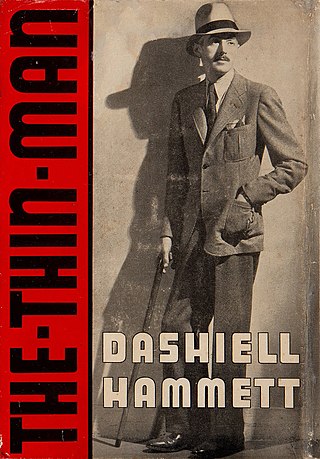
The Thin Man (1934) is a detective novel by Dashiell Hammett, originally published in a condensed version in the December 1933 issue of Redbook. It appeared in book form the following month. A film series followed, featuring the main characters Nick and Nora Charles, and Hammett was hired to provide scripts for the first two.
The Fat Man, a popular radio show during the 1940s and early 1950s, was a detective drama created by Dashiell Hammett, author of The Thin Man. It starred J. Scott Smart in the title role, as a detective who started out anonymous but rapidly acquired the name 'Brad Runyon'.
Carroll John Daly (1889–1958) was a writer of crime fiction. One of the earliest writers of hard-boiled fiction, he is best known for his detective character Race Williams, who appeared in a number of stories for Black Mask magazine in the 1920s.

The Glass Key is a 1942 American crime drama based on the 1931 novel of the same name by Dashiell Hammett. The picture was directed by Stuart Heisler starring Brian Donlevy, Veronica Lake and Alan Ladd. A successful earlier film version starring George Raft in Ladd's role had been released in 1935. The 1942 version's supporting cast features William Bendix, Bonita Granville, Richard Denning and Joseph Calleia.
Raoul Whitfield was an American writer of adventure, aviation, and hardboiled crime fiction. During his writing career, from the mid-1920s to the mid-1930s, Whitfield published over 300 short stories and serials in pulp magazines, as well as nine books, including Green Ice (1930) and Death in a Bowl (1931). For his novels and contributions to the Black Mask, Whitfield is considered one of the original members of the hard-boiled school of American detective fiction and has been referred as "the Black Mask's forgotten man".
"The House in Turk Street" is an early short story by Dashiell Hammett, featuring the Continental Op. It was first published in Black Mask in April 1924. This story indicates Hammett was turning towards themes of increasing violence in his stories, and its savagery has been commented upon, particularly the massacre which occurs at the end.
"Nightmare Town" is a short story written by Dashiell Hammett in 1924. It was first published in a December issue of Argosy All-Story Weekly magazine. It became the title story of a 1948 collection of four Hammett short stories published in paperback with illustrations. It appeared again in 1999, the eponymous story of a collection of twenty short stories edited by Kirby McCauley, Martin H Greenberg and Ed Gorman. It was adapted for BBC radio in June 2010 and read by Stuart Milligan.










